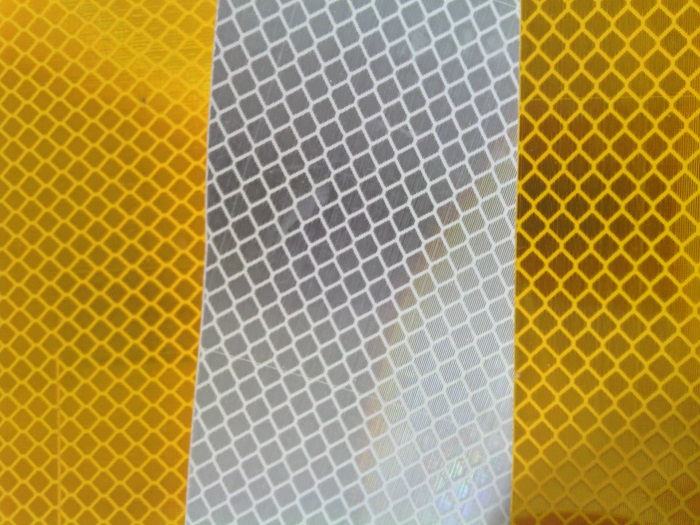Reflective film is a kind of retroreflective material which has been made into film and can be used directly. Using glass bead technology, micro prism technology, synthetic resin technology, film technology and coating technology and micro replication technology. Usually have white, yellow, red, green, blue, brown, orange, fluorescent yellow, fluorescent orange, Ying Guanghuang green, and abroad there are fluorescent red and fluorescent pink.



There are many ways to classify reflective films. Among them, the generally accepted classification principle is based on the basic structure of the reflecting unit, and the sorting method based on the inverse reflectance coefficient of the positive reflectivity of the reflecting film. But considering the different process of reflective film, some are designed to address the non positive retroreflected luminance, some consideration of two aspects of performance, but also some bad weather conditions for the visual requirements, so this classification, there are also shortcomings. Therefore, it is very necessary to know and master the application condition and design function of various reflecting vinyl.
In traditional custom, according to the structure of reflecting film reflecting unit, the reflective film is divided into two categories, glass bead type reflecting film and micro prism type reflecting film. Each type of reflective film are also contains many types, such as micro prism type reflective film, due to the use of more advanced techniques, the selection of material and the prism structure, there are a lot of changes, can deal with more traffic demand. According to the form and technical characteristics of the micro prism, prism type reflective film can be divided into inverse truncated prism reflecting film reflection ability is good for long-distance, short distance high angle reverse truncated prism reflective film reflection performance, and the prism reflective film into account all aspects of demand, fluorescent day and bad weather performance the whole prism reflective film, reflective film with prism retroreflective parameters of traditional engineering etc.. Glass bead type reflective film appeared earlier, but relatively few technological changes, there are two main types, a lens embedded type reflective film, traditionally known as the engineering grade reflective film; a sealed capsule, usually called high-strength reflecting film. In the lens embedded type reflective film, because of its appearance has a long history, the various manufacturers, in the manufacture of a long process, using lens diameter, density, corrosion resistance coatings with different thickness, making many kinds of reflective film, such as super engineering grade reflective film, which is based on engineering grade reflective film on the use of high quality glass beads, glass beads and the density increase, in order to improve the brightness of reflective film; commonly known as the economic level, mainly in the production of China, basically is based on engineering grade reflective film on the lens (glass beads) by reducing the number and density of realization way, these two kinds of reflective film, reflective film and the reflection of economy, ability to meet the needs of traffic safety, and more is in the business field, there are few in the world will be included in the traffic safety standards to light In.
According to the type of reflective film adhesive, reflective film can be divided into thermosensitive reflective film, adhesive reflective film and reflective film without glue. Traditional reflective coatings used in traffic facilities are mainly pressure-sensitive adhesive. Pressure sensitive adhesive, without heating, solvent or other preparations can be adhered to the smooth and clean surface, traffic signs generally pasted on the surface of aluminium or Aluminum Alloy. The stickiness of the thermosensitive adhesive is stimulated by heating the material and applying pressure. The reflective film without gum, usually used for traffic cone reflective tape coiling and temporary warning signs and facilities column reflection belt self supporting materials and manufacturing.
Reflective films are divided into 7 types in terms of their luminosity, structure and use.
I class, usually lens embedded glass bead structure, known as engineering grade reflective film, the service life is generally 7 years, can be used for permanent traffic signs and operating area facilities.
II class, usually lens embedded glass bead structure, called super engineering reflective film, the service life is generally 10 years, can be used for durability traffic signs deterioration operation area facilities.
III class, usually sealed capsule glass bead structure, known as high-strength reflective film, the service life is generally 10 years, can be used for permanent traffic signs and operating area facilities.
IV class, usually a micro prism structure, known as super reflective film, the service life is generally 10 years, can be used for permanent traffic signs, operating area facilities and contours.
V class, usually micro prism structure, known as large angle reflective film, the service life is generally 10 years, can be used for permanent traffic signs, work area facilities and contour mark.
VI class, usually micro prism structure, with metal coating, the service life is generally 3 years, can be used for contour and traffic column, no metal plating can also be used in the work area facilities and characters less traffic signs.
VII class, usually micro prism structure, flexible material, the service life is generally 3 years, can be used for temporary traffic signs and operating area facilities.




